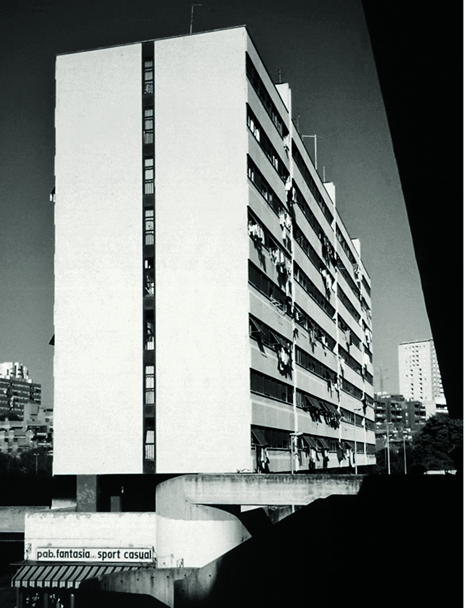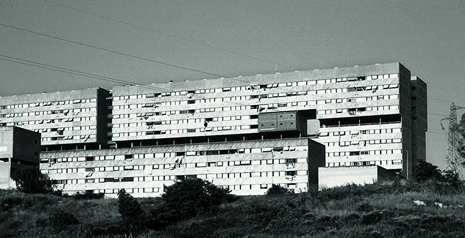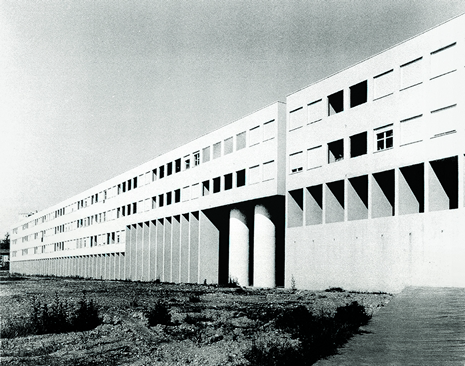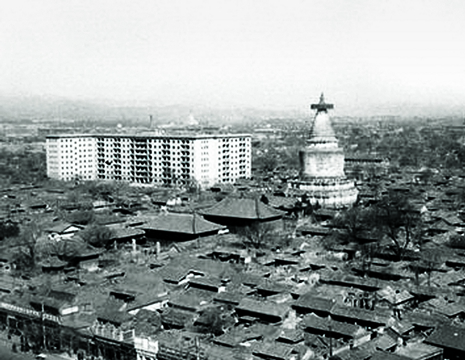Description
The housing category of ‘big buildings’ broadly conforms to a type of extensive residential complex that is generally mid-rise or mid-to-high-rise and where dwelling units and other functions are accommodated in a single structure or a few interlocked structures. The type also broadly conforms to the idea of the ‘submultiple’ providing for integrated dwelling environments at levels below that of a district but comparable to that of a neighborhood. More pointedly, they are complexes where housing and community services are no longer seen as separate facilities or spatially-separated functions, but are contained together in a single structure. The term ‘submultiple’ was coined by Leonardo Benevolo in 1984, among others, and was usually applied to single building complexes of 1,000 plus units and at densities of around 400 to 550 people per hectare. This is roughly equivalent to the idea of a neighborhood in a single building. Spatially, submultiples were at least partially supported by models of social interaction, which stressed the priority and centrality of certain functions over others. And while the quest for an appropriate submultiple was not unique to the modern era, its importance was certainly magnified by prevailing technocratic preoccupations with control, management, and functional interdependence of the modern era. In most cases, submultiples as big buildings were built in the post-Second World War period towards and on the periphery of cities in the cause of mass-produced housing. More recently, submultiples as big buildings have continued in this vein on greenfield sites, as well as on brownfield sites slated for large-scale redevelopment.
Big Buildings: Unit, type and use mixes
Although not exactly conceived of as a vertical neighborhood, the Unité d’habitation de grandeur conforme by Le Corbusier was of sufficient size and did conform within a single building all the local shops, services, and recreational opportunities for a community of some 1,200 to 1,600 people. Comparable to Fourier’s Phalanstère, with which Le Corbusier was quite familiar, the Unité was to be the basic cell of the new city. Furthermore, as a single building and plastic entity, the Unité promised to make the formation of subdistricts within a city architecturally tractable.
[1]
[2]
[3]
At much the same time as the Unités at Marseilles and Nantes, Fernand Pouillon designed and built his version in the new town of Climat de France at Oued Koriche in Algeria, completing it just before the War of Independence between 1958 and 1962. In the form of an enclosed perimeter block with a monumental peristyle surrounding the Place Bar el Aghab, also known as the Place of the 200 Columns, the entire edifice is large, at 260 meters in length and 65 meters in width. A clear precedent was the Maydan-i Shah at Isfahan in Iran, which Pouillon visited in 1955.
[4]
The submultiples of Rome in Italy got underway in the wake of the migratory influxes to the city during the 1950s and 1960s. The 1962 plan prepared the city for further peripheral development, incorporating the circumferential Grande Raccordo-Anulare (GRA) and the national Law 167 of the same year, and forced local administrations to expropriate land, at reasonable prices, proportional to local populations and assign it to the construction of public housing. Subsequently, Plans for Economic and Popular Housing (PEEPs) were designated within the areas zoned under Law 167 and construction commenced in 1964.
[5]
[6]
[7]

Quartiere Laurentino 38, Rome
Petro Barucci, 1976
Among the submultiples in the form of big buildings during this period, Corviale by Mario Fiorentino of 1972 through 1974 is among the most striking and controversial. Extending as a single building for one kilometer on a 60-hectare relatively isolated site inside the GRA, Corviale is reminiscent of the
[8]

Corviale, Rome
Mario Fiorentino, 1972-74
The tragedy of this and some other big building schemes from the era derived, at least in large part, from poor attempts to micro-manage living environments in the face of overwhelming complexities, exacerbated when the projects became dumping grounds for the poor, indigent, and drug abusers. Later projects, like the Quartiere di Torrevecchia, completed in 1984 and housing around 3,600 people, by Pietro Barucci again, were more modest and fared better.
[9]
Remaining in Italy but moving away from Rome, probably the most notable big building submultiple was the Gallaratese on the outskirts of Milan by Carlo Aymonino, Aldo Rossi, and Studio Ayde.

Gallaratese, Milan
Carlo Aymonino, Aldo Rossi and Studio Ayde
The property was owned and developed by the Monte Amiata Association, which commissioned the plan in 1967 and conveyed the finished project in 1974 to the City of Milan.
[10]
Elsewhere entirely, big buildings were also constructed, including the Fusuijing Commune in Beijing of the 1950s, Edificio Copan in São Paulo, Brazil, by Oscar Niemeyer of 1951, and Sewoon Sangga in central Seoul of 1967 by Soo-Guen Kim.

Fusuijing Commune, Beijing1950s
Moving into the contemporary era, in addition to the three cases defined in more detail in the next section of this chapter, other projects come to mind, including Via Verde in the Melrose neighborhood of the Bronx in New York City. This was a product of a competition organized in 2006 by Shaun Donovan, now the U.S. Secretary of the Department of Housing and Urban Development and then the Commissioner of New York City’s Department of Housing Preservation and Development.
[11]
th
[12]
[13]
Much like the tall tower typology that is used to provide a larger number of units, big buildings and submultiples also serve the same ends, although without the same site limitations but with a clear intent to incorporate other amenities and programs within a singular structure. The period of the 1990s and the turn of the twenty-first century saw a resurgence of this particular typology, including three remarkable projects completed in Amsterdam and Copenhagen. The two Dutch examples of interest are the Piraeus block and The Whale, designed by Hans Kollhoff and Christian Rapp, and de Architekten Cie respectively. Located in the Eastern Harbor District (Oostelijk Havengebied) of Amsterdam, the two projects are also representative of how former infrastructural sites, and in this case commercial docklands, could be transformed into new uses. Before Rotterdam emerged as the largest Dutch shipping port in 1962, Amsterdam’s development was in fact shaped profoundly by its harbors. The docklands in the Eastern Harbor were the first deep-water harbor in the city, and were created as landfill islands during Amsterdam’s ‘Second Golden Age’ in the latter half of the nineteenth century. The advent of railroads and steamships necessitated docks of much longer lengths to allow goods to be efficiently transferred to and from the sea-faring vessels.
[14]
After the Second World War, the Eastern Harbor District began to lose its competitiveness, so the city authorities decided to acquire the district and revealed in their 1978–1982 program that the islands would be redeveloped as a residential area. This initiative was further fleshed out in the Policy Document on Basic Principles on the Amsterdam Eastern Harbor District issued by the City Council in 1985, which coincided with a period of depopulation from the city center and an intense demand for housing. Subsequent urban renewal efforts focused on housing, due in large part to the considerable involvement of the Steering Group for Supplementary Housing.
[15]
[16]
The KNSM-eiland was the first of the docklands in the district to be redeveloped. Two structural layouts were proposed: the first was by Arne van Herk and Sabine de Kleijn where building strips in an open parcel were to be positioned in relation to the dock; the second was by the Spatial Planning Department (DRO) which promulgated for large, enclosed residential buildings of six to eight storeys in height, opening to views of the water on one side, and to an avenue, plaza, or courtyard on the other.
[17]
[18]
Coenen’s master plan had prescribed the two monumental buildings to be composed of large perimeter blocks with circular courtyards, complete with commercial space, shops, and restaurants along their ground levels. In the case of what was later renamed the Piraeus block, there was also a stipulation by the city to preserve the old KNSM administration building located right at the center of the southern façade. Rather than translating Coenen’s vision directly into built form, Kollhoff and Rapp took his plan as a starting point, transforming the monolithic volume submultiples measuring 170 meters long by 60 meters wide into what later became one of the most outstanding and influential buildings in the Eastern Harbor District. Kollhoff and Rapp first did away with the circular courtyard, moulding the limbs instead into folded wings wrapped around the conservation landmark before enjoining the northern length of the block. In making these folds, asymmetrical wedges were cut out from the block, especially along the eastern half of the volume, thereby offering some visual relief from what would have been a monotonous front along the southern edge, while also serving as a spatial funnel guiding pedestrians through a passageway connecting this new block back to KNSM-laan. To preserve the links to the former dockland park to the west, the architects opened up the western edge of the block on the first five storeys, allowing the remaining floors of housing above to float on an arcade of slender columns, thereby maintaining the visual and physical continuity between the park and the open garden within this western half of the volume. Finally, to maximize views on this waterfront site, the architects played with the overall elevations, retaining the maximum height on the northern edge while reducing the height gradually along the western and eastern edges of the block to approximately six storeys on the southern elevation, before dropping down eventually to four storeys at the tail end of the wings tucked back under the opening on the northern edge. In addition, the roofs of the sculptural block were sloped downwards back into the block punctuated by skylights, so as to let sunlight from the south into the courtyard and the units on the top floors, apart from opening up views to the waterfront for the residents in the northern edge.
Constructed primarily with bricks in keeping with the materiality of the small, historic building it wraps around, the massive building is topped with an uninterrupted aluminum roof that further accentuates the coherence of the mega-form but also acts as a reflective surface increasing the diffusion of light within the courtyards. Apart from harkening back to the expressionism embodied by the Amsterdam School of Architecture with their playful use of bricks to create an integrated architectural sculpture, the choice of brick further underscores Kollhoff’s belief that “the architecture of the city center needs to look solid”.
[19]
The overall coherence of the Piraeus block and its classical style of straight continuous lines and regularly spaced windows that seem to suggest an internal repetition belies the fact that the building contains an impressive diversity of living units. In total, it houses more than 50 different unit types within 304 rental apartments, varying from studios to three-bedroom apartments, and between 82 to 174 square meters, with a mix of live-work and non-live-work units. The residential density too, not surprisingly, is high at 298 dwelling units per hectare. Within the assortment of unit types, there appears to be a general convergence on a basic type that is rectangular in shape, containing a centralized core of service elements flanked by a living axis and a smaller, secondary service axis, as well as a thickened boundary and a glazed winter garden along the exposed façade. The more unique layouts though arise largely from conditions where the building envelope deviates from the orthogonal, such as the unusual folds in the building, as well as where the sloping roof defines the upper limits of an apartment unit. As the first building to be constructed on KNSM-eiland and completed in 1994, the Piraeus attained a tectonic expression central to Kollhoff’s works, and stands as a timeless, civic tribute that also recalls the warehouses of its infrastructural heritage.
Situated directly across the water from the Piraeus block is yet another striking landmark in this Eastern Harbor District – The Whale. Finished in 2000, this housing complex by de Architekten Cie is part of the Borneo-Sporenburg redevelopment that began in 1996, after the completion of KNSM-eiland. The plan called for a low-rise, high-density residential district, on the order of 100 dwelling units per hectare. The Whale is one of three large sculptural blocks or ‘meteorites’ as they were dubbed by Adriaan Geuze from West 8, that were interdicted within this low-rise milieu in the firm’s urban planning vision for the two islands. Together, they were positioned strategically to relate visually to other significant points in the surroundings, including the waterfront and the assertive presence of the Piraeus block. Of the three, only The Whale and the Pacman, located on Borneo island by Koen van Velsen, were materialized; the Fountainhead, designed by Kees Christiaanse, remains unbuilt. Comprising 150 social housing units and another 64 private apartments for rent, the silver-grey, zinc-clad project rises above a sea of brown brick row houses when viewed from afar.
[20]
Designed by West 8, the small courtyard garden continues the silver-grey piscine theme through the placement of four free-standing 18-foot-tall zinc vases along a path laid with Norwegian slate, set within a manicured lawn interspersed with several geometrically-shaped hedges and Gingko trees. Unlike the open courtyards of the Piraeus, this enclosure at The Whale is only visually accessible, meant clearly for viewing and contemplation rather than for occupation and interaction. The ground floor of the project is lined with commercial premises, distinguished from the residential apartments above with their floor-to-ceiling glazed façades. Access to the apartments is limited to the two glass stairways at the base of the building’s lifted corners, connected by L-shaped, or straight, horizontal galleries that alternate between the even- and the odd-numbered floors, and every other floor is linked by a secondary system of stairs grafted to the exterior of the building within the courtyard. These galleries and railings are covered in warm larch wood, contrasting with the cool, metallic finish of the external fenestration with its uniform bands of windows that alternate every other floor. In terms of unit variation, The Whale has a smaller range compared to the Piraeus block, with several standard plans that line the center of each side, and the corners as well as the top levels under the sloped roof and soffit planes occupied by deviations from the norm, including larger units and duplexes. The units are generally divided length-wise in their spatial organization into a living axis as well as a secondary service axis; the bathrooms are typically located in the center of the units, with the kitchen adjacent or right across an internal corridor. Each unit is dual aspect and no more than 14 meters deep, offering views to both the courtyard and the surroundings but also returning again to the fundamental design principle of bringing plenty of light into dwellings. While it does not share the same degree of unit diversity as the Piraeus block, The Whale does accommodate an even higher residential density of 428 dwelling units per hectare.
An iconic submultiple that represents an experiment in generating diversity of unit types taken to a whole other level is the 8 Tallet project by Bjarke Ingels Group (BIG) completed in 2010. Unlike the brownfield redevelopments undertaken in the two examples above, this project was constructed on a greenfield site in Ørestad, a new five-kilometer strip of development in southern Copenhagen between the historic city and the Kalvebod Fælled (Common) nature reserve. Just 10 minutes to the city center by metro, Ørestad was planned as Copenhagen’s ‘sixth finger’ of urban growth in 1994, and is expected to accommodate 20,000 residents and 60,000 to 80,000 employees by the time it is completely built out.
[21]
[22]
In 2006, St. Frederikslund Holding and Høpfner Projects Ltd commissioned the BIG team to design what was then Denmark’s largest private residential development at the very edge of the nature reserve. In particular, this was a collaboration initiated by Per Høpfner who had already formed a working partnership with Bjarke Ingels dating back to two earlier projects also in the Ørestad – the V & M Houses, and the Mountain House – which were designed by PLOT before Ingels and Julien De Smedt parted ways. As at The Whale, the BIG team started with a 10-storey, 230 meters by 110 meters perimeter block. Rather than adhering to the conventional Danish treatment where the variation on the façade is produced as a serial permutation of different waterfront row houses, the team decided instead to stack the functions: they began with a commercial base, followed by a layer of row houses as a modern interpretation of the traditional
From Ingels’ perspective, 8 Tallet was designed to be a “three-dimensional neighborhood rather than an architectural object… [w]here social life, the spontaneous encounter, and neighbor interaction traditionally… restricted to the ground level” is allowed to “expand all the way to the top”.
[23]
[24]
Looking across this material depicting big buildings as submultiples in the pursuit of housing communities, several common issues are present. The first involves striking an appropriate balance among residential and related functions. A core idea of the submultiple typology is an alignment between dwelling and its necessary and desirable non-residential services and suppliers at convenient scales and eases of access. One advantage, in these regards, of big buildings is that they can readily allow for physical proximity and connection within a single facility. A disadvantage is that the scale and number of supporting non-residential facilities can be limited in physical terms to the geometry and scale of the residential aspect of big buildings. In short, footprints, modes of access, and orientations often do not readily match. Also, the inherently deterministic approach used in the development of many big building submultiples can be roundly criticized by simple observations: just because a certain number of dwelling units is sufficient to support a particular facility does not mean that all people in the building will use the facility. On the contrary, the more isolated the facility is from other similar facilities, the less likely it is to survive. Nevertheless, in the relative absence of this determinism in today’s housing environments, it is an open question what is in a big building serving as a submultiple of a non-strictly residential nature. Or to put it the other way around, especially in relatively undeveloped sites either inside or on the edge of urban areas, it is what is
A second issue involves big buildings and the accommodation of different dwelling unit types. This concerns circumstances of assemblage and how to achieve a certain sense of wholeness alongside of diversity in accommodation. Here, at least four different strategies can be observed. First, and especially in the case of the Unités
A third issue is the making of a distinctly recognizable civic and public space and even one that stands in its representational significance above or outside of its immediate residential environment. As with Rossi and Pouillon and their uses of loggias, galleries, and arcades, this can be accomplished in a monumental manner, or at least in a form that is clearly civic-minded in appearance. It can also be accomplished via well-shaped and developed community and public courtyard spaces as in the Piraeus and The Whale in Holland. In addition, the magnification of a common feature related to dwelling, like its ancillary landscape, can be accomplished to register a community and even civic presence. This is clearly on display at Via Verde in the Bronx of New York City and at 8 Tallet in Copenhagen with cascading gardens and earthworks. Especially at the scale of more or less the equivalent of a neighborhood in a single building, some sense of a collective civic identity seems to be warranted, sometimes if not often complicating the search for an architectural solution for something that has become more than simply a building.
Footnotes
David Jenkins, Unité d’Habitation, Marseille: Le Corbusier (London: Phaidon Press, 1993).
Stanislaus von Moos, Le Corbusier: Elements of a Synthesis (Cambridge, MA: MIT Press, 1979), 204.
“Unité d’Habitation à Nantes-Rezé, France,” Architecture d’Aujourd’hui 66 (July 1956): 2–11.
Bernard Félix Dubor, Fernand Pouillon (Paris: Electa France, 1986).
Piero Ostilio Rossi, Roma: Guida all’Architettura Moderna, 1909–1991(Rome: Laterza, 1991), 258–261; and Italo Insolera, Roma Moderna: Un Secolo di Storia Urbanistica, 1870–1970 (Turin: Piccola Biblioteca Einaudi, 1993), 264–277.
Rossi, Roma, 262–265.
Rossi, Roma, 314–317.
Rossi, Roma, 321–323.
Rossi, Roma, 333–336.
Yukio Futagawa, Global Architecture: Carlo Aymonino/Aldo Rossi, Housing Complex at the Gallaratese Quarter, Milan, Italy, 1969–1974 (Tokyo: ADA. EDITA, 1977).
Joann Gonchar, “Affordable’s New Look, New York City: With Via Verde – a Mixed-use Complex in a Rapidly Changing Bronx Neighborhood – Dattner & Grimshaw Reimagine City Dwelling,” Architectural Record 200 (July 2012): 97–101.
Michael Kimmelman, “In a Bronx Complex, Doing Good Mixes With Looking Good,” New York Times, September 26, 2011, accessed October 15, 2013, http://www.nytimes.com/2011/09/26/arts/design/via-verde-in-south-bronx-rewrites-low-income-housing-rules.html?pagewanted=all&_r=0
Kimmelman, “In a Bronx Complex, Doing Good Mixes With Looking Good”.
Jaap Evert Abrahamse, “Amsterdam on the sea: The historic development of the Eastern Harbour District,” in Eastern Harbour District Amsterdam: Urbanism and Architecture, ed. Jaap Evert Abrahamse et al. (Rotterdam: NAi Publishers, 2006), 9.
Allard Jolles, “Tail Winds,” in Eastern Harbour District Amsterdam: Urbanism and Architecture, ed. Jaap Evert Abrahamse et al. (Rotterdam: NAi Publishers, 2006), 25–26.
Allard Jolles, “Tail Winds”, 27.
Marlies Buurman, “KNSM Island,” in Eastern Harbour District Amsterdam: Urbanism and Architecture, ed. Jaap Evert Abrahamse et al. (Rotterdam: NAi Publishers, 2006), 58.
Buurman, “KNSM Island”, 59, 61, 63.
Hans Kollhoff, “Against the Taboos of an Urban Architecture,” Domus (April 1995): 107.
“‘The Whale’ residential complex, Amsterdam”, Cie, accessed November 2, 2013, http://www1.cie.nl/projects/projects/residential/the-whale,-amsterdam.aspx
“Facts on Ørestad,” Ørestad, accessed November 2, 2013, http://www.orestad.dk/Fakta.aspx
1994 Competition Stipulation cited in “Copenhagen Growing: The Story of Ørestad,” Ørestad, accessed November 2, 2013, http://www.orestad.dk/Fakta/~/media/Orestadhttps://bdt.degruyter.com/cdn/wp-content/uploads/dgimport/pdf/Copenhagen-Growing_web.ashx
Bjarke Ingels, cited in “Copenhagen’s BIG Architects Complete 8 House Landmark Residential Project,” by Alma Kadragic, World Property Channel, accessed November 2, 2013, http://www.worldpropertychannel.com/featured-columnists/uae-watch-big-bjarke-ingels-group-8-house-guinness-book-of-records-emaar-burj-khalifa-stfredeikslung-holding-per-hopfner-hopfner-partners-3367.php
Bjarke Ingels, cited in “8 House, Village Gigantesque = 8 House, A Giant Village,” by Marie-Douce Albert, Architecture d’Aujourd’hui 380 (November–December 2010): 155.
Internal Links
Originally published in: Peter G. Rowe, Har Ye Kan, Urban Intensities: Contemporary Housing Types and Territories, Birkhäuser, 2014.